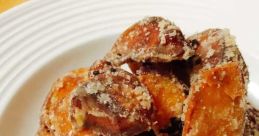| Title |
芋頭 |
| Board | Random 芋 Sounds |
| Format | MP3 |
| Length | 0 seconds |
| Plays | 0 plays |
| Auto Transcribed | No |
| Download | |
| More | |
| Aural Matches | |
| Share |
This MP3 audio sound quote is from:
The first sound that comes to mind when thinking about 芋 is the soft squishy sound of 芋泥包 being formed. This traditional Chinese dessert is made from mashed taro mixed with coconut milk and sugar, then wrapped in a delicate pastry dough before being deep-fried to crispy perfection. The process of shaping the taro filling into small balls creates a distinct sound as the mixture is squished and molded, giving the 芋泥包 its signature shape and texture. This sound is a familiar one in Chinese kitchens, a rhythmic reminder of the delicious treat that is soon to come.
Another sound associated with 芋 is the chopping and slicing of the 芋頭, or taro root. The hard and starchy texture of the taro requires a sharp knife to cut through, resulting in a series of firm and deliberate thuds as the vegetable is prepared for cooking. The sound of the knife piercing through the tough outer skin and into the dense flesh of the taro is a satisfying one, indicating the start of a flavorful dish to come. Whether it's being diced for a stir-fry or boiled for a comforting soup, the sound of 芋頭 being prepped is a harmonious prelude to a delicious meal.
In addition to these kitchen sounds, there are also natural sounds associated with the growth of taro plants. The rustling of the large tropical leaves as they sway in the breeze, the gentle splashing of water as the plants are irrigated, and the soothing hum of bees as they pollinate the taro flowers all contribute to the symphony of sounds that accompany the cultivation of this versatile root. The rhythmic pattern of these natural sounds creates a tranquil ambiance in the taro fields, a peaceful backdrop to the hard work and dedication required to grow this staple crop.
Moving beyond the realm of food and agriculture, the sound of 芋 also holds cultural significance in various forms of Chinese art and performance. In traditional Chinese opera, the striking of wooden blocks together create a percussive rhythm known as "芋打." This rhythmic pattern serves as a musical backdrop to the dramatic performances on stage, adding depth and intensity to the storytelling. The sharp and crisp sound of the wooden blocks being struck together punctuates the emotional highs and lows of the opera, enhancing the overall experience for the audience.
If you are interested in experiencing these sounds for yourself, you can play and download recordings of them here. Immerse yourself in the world of 芋 as you listen to the squishy sound of 芋泥包 being formed, the satisfying thuds of the 芋頭 being chopped, the tranquil rustling of taro leaves in the breeze, and the rhythmic beat of the wooden blocks in a Chinese opera performance. These sounds offer a sensory journey into the world of 芋, providing a deeper appreciation for the cultural and culinary significance of this versatile root vegetable.
So take a moment to listen and appreciate the unique sounds of 芋, allowing yourself to be transported to a world where these simple yet profound noises hold a special place in Chinese culture and cuisine. Enjoy the symphony of sounds that accompany the 芋 experience, and savor the rich tapestry of flavors and traditions that this humble root vegetable embodies.
